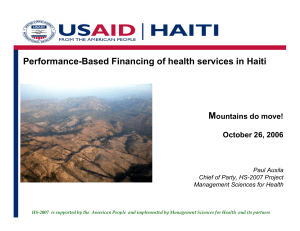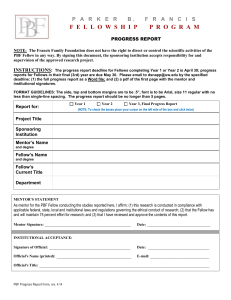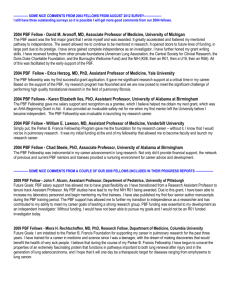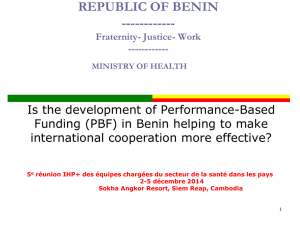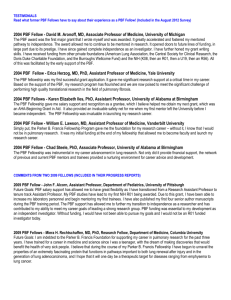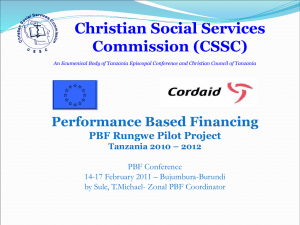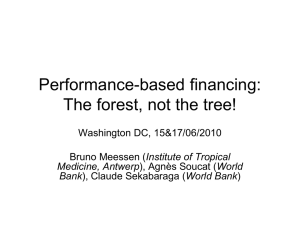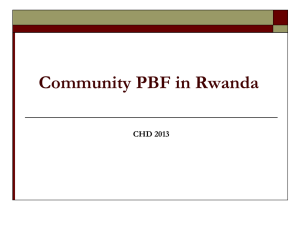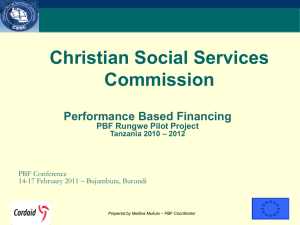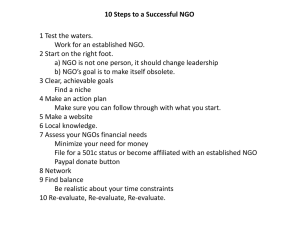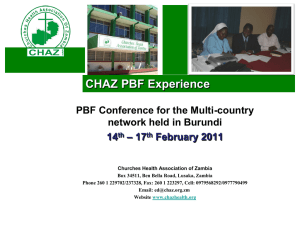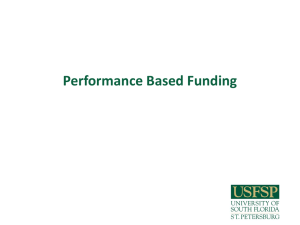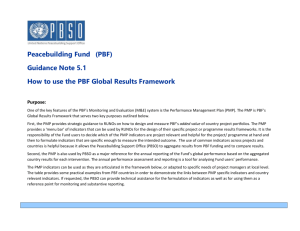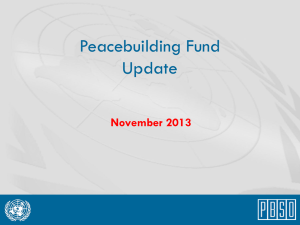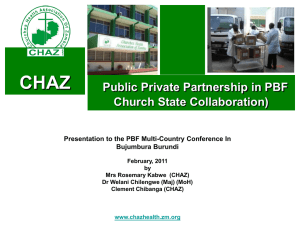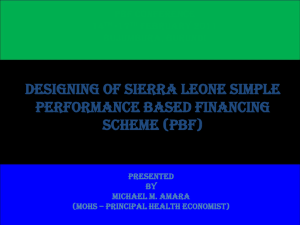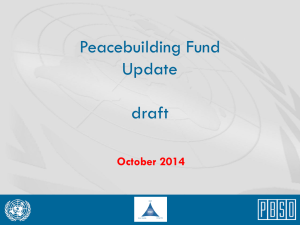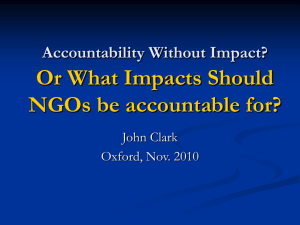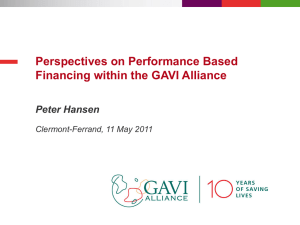Rebuilding Basic Health Services in Liberia
advertisement
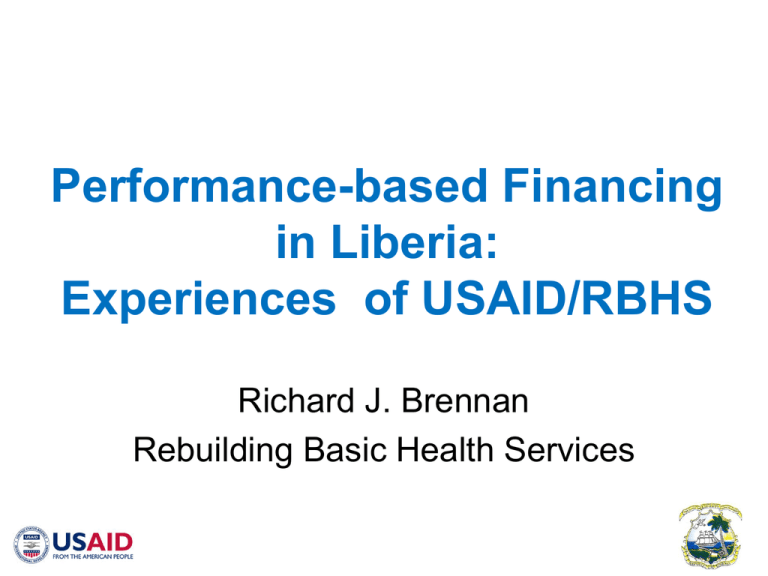
Performance-based Financing in Liberia: Experiences of USAID/RBHS Richard J. Brennan Rebuilding Basic Health Services Rebuilding Basic Health Services Overview • Largest USAIDfunded health project in Liberia – Nov 2008 – Oct 2013 • Overall goal: assist MOHSW with implementation of National Health Plan • Three pillars – Service delivery – Systems strengthening – BCC • Service delivery – Implemented through performance-based contracts Performance-based Financing in Liberia Facilities Covered by PBF • RBHS PBCs – July 09 – June 11 – 4 NGOs (5 contracts) – 1 NGO grant; 15 facilities 110 97 USAID/RBHS MOHSW - CHT • MOHSW Pool Fund – November 2009 – March 2010 19 MOHSW NGOs PBF and RBHS • Objectives of PBCs – Service delivery at facility & community levels – Capacity building of CHTs • Indicator selection – Highly consultative • Determining baselines and targets – Individualized by NGO Administrative Indicators • Reported quarterly; possible penalty associated INDICATOR • # joint and total supervisory visits • % of timely, accurate and complete HIS reports submitted to the CHT • % of staff funded by NGOs paid on time • # of Community Health Development Committees meetings held per facility • Submission of timely and complete quarterly report to RBHS BASELINE TARGET Performance Indicators • Reported quarterly: annual performance bonus (year 1); quarterly bonus (from year 2) INDICATOR BASELINE TARGET • % of priority facilities reaching one-star level in accreditation survey • % of facilities with no stock-out tracer drugs • % of patients receiving no more than 3 drugs • % of children under 1 year who received DPT3/pentavalent-3 • % of children under 5 years with malaria who are treated with ACTs • % of pregnant women provided with 2nd dose of IPT for malaria • % of deliveries that are facility-based with skilled attendant • Number of people tested for HIV and received their results •Couple-years of contraceptive protection provided by RBHS-supported facilities PBF Management: Verifying data • Process – Quarterly – Random selection of 3 facilities per NGO – Cross check reports with ledgers / records • Challenges – Definitions, e.g. supportive supervision – Reporting issues, e.g. ORS, ACT – Discrepancies between facility reports and ledger reviews by RBHS PBF Management: Verifying Data • Progress: Quarter 1 to Quarter 6 – Clarification of definitions – Data verification instituted by NGOs – Fewer discrepancies • Results – Increased capacity in data management – facility and NGO staff – Improved data quality – Improved understanding and use of data PBF Management: Feedback & Communication • • • • • Monthly all-partner meetings Quarterly data reviews – all partners, MOHSW Quarterly partner feedback Annual stakeholders’ meeting Others – County Coordinator reports – Ad hoc meetings – Field visits Targets met (of 14) RBHS Partners‘ Performance on PBF Indicators, by NGO, Oct-Dec 2010 14 13 12 11 10 9 8 7 6 5 4 3 2 1 0 5 5 Administrative (of 5) Service delivery (of 9) 3.9 3 3.5 4 9 6.0 3 8 5 5 3 6 Distribution of Performance Bonuses • Frequency – Year 1: Annual bonus – Year 2: Quarterly bonus • Incentive systems determined by NGO partner, CHT, and health staff • Distributed at all levels – – – – CHT Facility Community NGO staff Distribution of Performance Bonuses AFRICARE EQUIP IRCLOFA IRCNIMBA MTI 70% 41% 19% 35% 38% - 19% 69% 50% - CHT staff 14% 4% 12% 15% 8% CHT office upgrades - 3% - - 11% NGO staff 16% 24% - - 21% NGO office upgrades - - - - 19% Community - 6% - - - Awards & ceremonies + 2% + + 3% Facility staff Facility upgrades Proportion of pregnant women Maternal health, RBHS-supported Facilities Jul 2009-Dec 2010 100% • IPT2 = 132% increase 90% 80% 70% 60% 50% 40% 30% IPT2 20% 10% 0% •Facility deliveries = 189% increase Facility deliveries Malaria Treatment, RBHS-supported Facilities, Jul 2009-Dec 2010 16,000 14,000 Number of children U5 12,000 10,000 8,000 6,000 Malaria 4,000 2,000 0 ACT EPI, RBHS-supported Facilities, Jul 2009-Dec 2010 120% % children U1 vaccinated with penta-3 100% 80% 60% 40% 20% 0% 1,000 900 5,000 800 700 4,000 600 3,000 500 400 2,000 1,000 300 FP counseling CYP 200 100 0 0 CYP rise: health fair, refugee influx, implants Couple-years of protection Number of FP counseling visits 6,000 Support to MOHSW • Selection and harmonization of national indicators • Determination of preliminary baselines and targets • Development of PBC payment plan and tool Lessons learned • Need precision in indicator definitions • Importance of flexibility and leniency in setting targets and assessing progress • Value of validation process in building capacity • Annual payment of bonus too infrequent • Need to provide more guidance on bonuses Future directions • Improve data collection with new HMIS • Involve CHT members and facility staff more in tracking PBF • Introduce facility feedback tool – Graphs of last 12 months’ data updated monthly – Posted at each RBHS facility and updated monthly Future Directions • Support to MOHSW on PBF – Develop PBF database (national and country level) with MOHSW – Conduct costing of PBF program (management costs and future extension) – Development of the national PBF procedures manual – Development of PBF M&E and verification manual and tools
